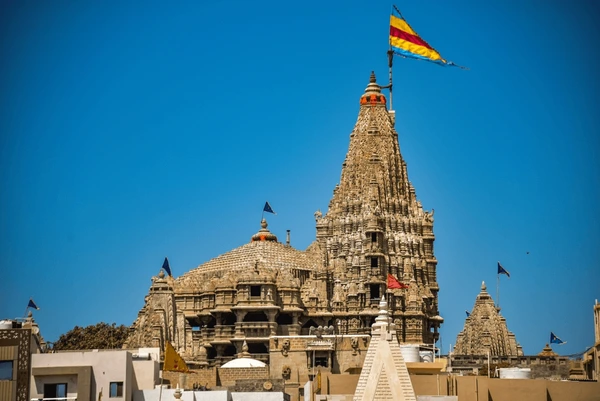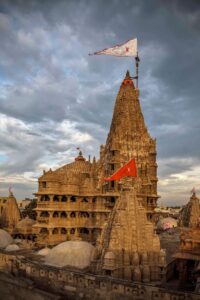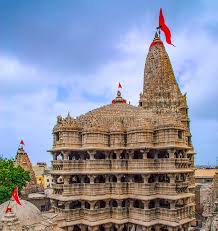
Table of Contents
Dwarka
Ancient Majesty of Dwarka
 Dwarka
Dwarka
View of Gomti Ghat and Krishna Temple “Shree Dwarkadhish”. Dwarka, Gujarat, India
Dwarka, one of the holiest cities in India, is steeped in mythology and history. Believed to be the ancient kingdom of Lord Krishna, it is a significant pilgrimage site for Hindus. Located in Gujarat, this sacred city is home to the renowned Dwarkadhish Temple, a magnificent structure dedicated to Krishna.
Dwarka is also famous for its submerged city, which historians and archaeologists believe may be one of the oldest civilizations in India. The city’s serene beaches, like Gomti Ghat and Beach, offer a peaceful retreat for visitors.
Nearby, the island of Bet Dwarka is another revered site, accessible by boat. Rukmini Devi Temple and Nageshwar Jyotirlinga add to the spiritual significance of the region.
With its blend of religious devotion, historical intrigue, and coastal charm, a must-visit destination for travelers seeking spiritual enlightenment and cultural heritage in the heart of Gujarat.
A City of Mythology and Legend
According to Hindu mythology, Dwarka was established by Lord Krishna himself after he left Mathura. It is believed that the city was built by the divine architect Vishwakarma and was once a magnificent, golden kingdom. Ancient scriptures mention that the original was submerged into the sea, a theory supported by marine archaeological explorations that have discovered remnants of an underwater city near present-day Dwarka.
The Majestic Dwarkadhish Temple
One of the primary attractions is the Dwarkadhish Temple, also known as the Jagat Mandir. Dedicated to Lord Krishna, this temple stands as a remarkable example of Hindu architecture. Built over 2,500 years ago, the temple features a stunning five-story structure supported by intricately carved pillars. Devotees flock here to witness the grand Aarti and seek blessings from the deity.
The temple’s Shikhara (spire) rises to a height of approximately 78 meters, adorned with a colossal flag that is changed multiple times a day. The sanctum houses the idol of Lord Krishna, also known as Dwarkadhish or the King in a striking black stone form. The temple complex also includes smaller shrines dedicated to deities such as Rukmini, Balarama, and Radha.
Pilgrims enter the temple through the Moksha Dwar (Door to Salvation) and exit through the Swarga Dwar (Door to Heaven), symbolizing the spiritual journey of life. The temple remains a hub of religious activity, especially during festivals like Janmashtami, when thousands gather to celebrate Krishna’s birth with grand processions, devotional singing, and vibrant cultural performances.
Apart from its religious significance, the temple is also an architectural marvel, showcasing intricate carvings and sculptures that depict various episodes from Krishna’s life. The serene atmosphere and the rhythmic chants of priests performing daily rituals add to the temple’s divine aura, making it an unmissable spiritual destination.

Bet Dwarka: The Island of Krishna’s Legacy
Bet Dwarka, an island near the coast of Dwarka, is another important religious site. It is believed to be the residence of Lord Krishna during his reign. Visitors can reach Bet via a short boat ride from Okha port. The temple here, dedicated to Lord Krishna, is believed to house the deity’s original idol gifted by Rukmini, his consort.
Spiritual and Historical Attractions
Apart from the Dwarkadhish Temple, the city boasts other prominent religious and historical sites:
- Rukmini Devi Temple: Dedicated to Krishna’s beloved queen, this temple is known for its intricate carvings and spiritual importance.
- Nageshwar Jyotirlinga: One of the twelve Jyotirlingas of Lord Shiva, this temple is a must-visit for Shiva devotees.
- Gomti Ghat: A sacred spot where the Gomti River meets the Arabian Sea. Devotees take a holy dip here before visiting the Dwarkadhish Temple.
- Sudama Setu: A bridge named after Sudama, Lord Krishna’s childhood friend, offering panoramic views of the Gomti River.
Marine Archaeology and the Lost City of Dwarka
The legend of Dwarka’s submersion has fascinated historians and archaeologists for centuries. Marine excavations off the coast have revealed submerged structures, indicating the existence of an ancient city beneath the Arabian Sea. These findings suggest that might have been one of India’s earliest urban settlements, adding to its historical and archaeological significance.
Best Time to Visit Dwarka
The best time to visit Dwarka is between October and March when the weather is pleasant and ideal for sightseeing. The city is especially vibrant during Janmashtami, the festival celebrating Lord Krishna’s birth, attracting thousands of devotees.
During this period, the temperatures range from 15°C to 30°C, making it comfortable for outdoor activities and temple visits. Winters in are mild, allowing visitors to explore the city without extreme heat or humidity. Apart from Janmashtami, other important festivals such as Holi and Diwali also bring a festive atmosphere, with temples adorned in lights and devotional songs filling the air.
For those who prefer a quieter experience, visiting in the months of October, November, February, or March provides an opportunity to explore attractions at a relaxed pace, avoiding the peak crowd. The evenings by the Arabian Sea during these months are particularly enchanting, offering mesmerizing sunset views and a peaceful ambiance for spiritual contemplation

How to Reach Dwarka
Dwarka is well-connected by road, rail, and air:
- By Air: The nearest airport is Jamnagar Airport (137 km away), with regular flights from major cities like Mumbai, Delhi, and Ahmedabad. From Jamnagar, travelers can hire a taxi or take a bus to Dwarka, which takes around 3-4 hours.
- By Train: Dwarka Railway Station is well-connected to major cities such as Ahmedabad, Rajkot, Mumbai, and Vadodara. Trains like the Saurashtra Express and Okha Express provide convenient travel options. From the railway station, local transport options like auto-rickshaws and taxis are available to reach various parts of the city.
- By Road: Dwarka has a well-developed road network, making it easily accessible by bus and private vehicles. Gujarat State Road Transport Corporation (GSRTC) operates regular buses from major cities such as Ahmedabad, Rajkot, Jamnagar, and Surat. Private bus operators also offer comfortable sleeper and AC buses. For a more flexible travel experience, hiring a cab or driving from nearby cities is a convenient option.
For those traveling from Ahmedabad, a road trip to Dwarka via Rajkot and Jamnagar offers scenic views of Gujarat’s landscapes, including salt plains, rivers, and small villages, enhancing the overall journey.
Conclusion
Dwarka is more than just a religious destination; it is a city that blends mythology, history, and coastal beauty. Whether you seek spiritual solace, historical exploration, or a peaceful getaway, offers an enriching experience for all travelers. A visit to this divine city is a journey through India’s rich cultural and religious heritage.
Beyond its religious appeal serene landscapes and pristine beaches make it a perfect retreat for nature lovers. The city’s unique blend of spirituality and tranquility attracts seekers from all over the world, offering moments of self-reflection and divine connection.
For adventure seekers, a boat ride to Bet Dwarka provides an opportunity to witness breathtaking ocean views. Exploring the narrow lanes around the temples offers a glimpse into the vibrant local culture, with traditional handicrafts and delicious Gujarati cuisine adding to the charm of the visit.
As the sun sets over the Arabian Sea, the sight of the illuminated temples and the sound of devotional hymns create an ethereal experience. Whether you are a devotee, a history buff, or a traveler in search of peace promises an unforgettable journey into India’s spiritual and cultural heartland.

Dwarka Temple Map
Follow More Article
